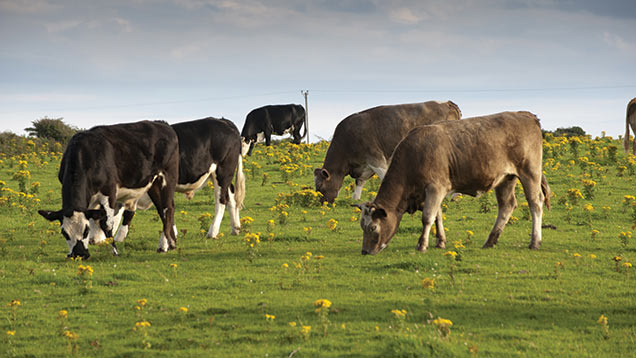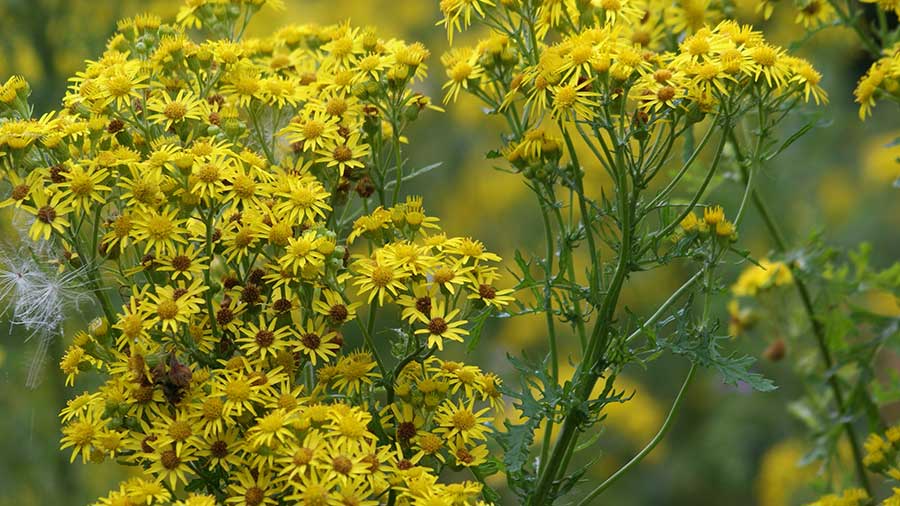Guide to rules on ragwort control for livestock farmers
 ©FLPA/Rex Shutterstock
©FLPA/Rex Shutterstock The weed common ragwort is a toxic plant that can pose a significant threat to grazing livestock.
It is a sufficient enough hazard to be included in law as an ‘injurious weed’ and can be an offence when left uncontrolled, leading to fines for the landowner.
What is common ragwort?
Common ragwort is a weed and is toxic to livestock. It grows up to between 30-90cm (1-3ft) high, has tough stems, which are often tinged red near the base, but brighter green and branched above the middle.
All the leaves are dark green and rather tough and may be sparsely hairy on the lower side. The leaves are finely divided and ‘feathery’ and have a basal rosette of deeply-cut, toothed leaves.
The plant flowers from June to November with densely packed yellow clusters which have flattened flower heads, and appear daisy-like. Although it may be considered a pretty plant is has an unpleasant smell when crushed or bruised.
Common ragwort is a danger to all stock, but particularly horses, cattle, free-range pigs and chickens.
See also: How regenerative farming can improve livestock health

Common ragwort © AdobeStock/Hedgehog
Why is ragwort a problem?
Ragwort contains alkaloids which cause cirrhosis of the liver and there is no no effective treatment once clinical signs appear.
Although largely unpalatable, animals may eat ragwort when the plant is green and when other grazing is sparse. Cattle are more susceptible to poinsoning from the plant than sheep and sheep can tolerate it in small amounts.
Symptoms of cirrhosis of the liver can present as chronic weight loss, diarrhoea, jaundice, and accumulation of fluid under the jaw and brisket, lethargy and dullness (Source: Nadis).
In cattle most cases of ragwort poisoning will occur over a period of weeks or months of eating the plant but the signs can take up to 18 months to show.
It is palatable when dead or dying because of the release of sugars, so contamination of hay or silage is very dangerous.
Ragwort is a toxic plant and suitable precautions must be taken when handling live and dead plants. Hands must be protected and arms and legs should also be covered.
What are the rules regarding ragwort?
Ragwort is classed as one of five injurious weeds under the Weeds Act 1959 and is also covered by the Ragwort Control Act 2003, which provides for the publication of a Code of Practice on Ragwort Control.
It is not an offence to have ragwort growing on your land and can have conservation benefits, attracting butterflies, bees and other beneficial insects. However, it must not be allowed to spread to agricultural land, particularly grazing areas or land which is used to produce conserved forage.
If ragwort is found to be growing on any land, Defra can serve a notice requiring the occupier to take action to prevent the spread of those weeds. An unreasonable failure to comply with a notice is an offence.
What should I do if I find ragwort on my land?
When your land is affected by ragwort you should make an assessment to determine whether action should be taken to prevent the spread of ragwort to neighbouring land by establishing the risk posed to grazing animals or forage production.
Defra provides the following three risk categories as guidelines for assessing the risk.
High risk:
- Ragwort is present and flowering/seeding within 50m of land used for grazing by horses and other animals or land used for feed/forage production. Where a high risk is identified take immediate action to control the spread of ragwort using an appropriate control technique.
Medium risk:
- Ragwort is present within 50m to 100m of land used for grazing by horses and other animals or land used for feed/forage production. In this case establish a control policy to ensure that where a change from a medium to a high risk of spread can be anticipated, it is identified and dealt with in a timely and effective manner using appropriate control techniques.
Low risk:
- Ragwort or the land on which it is present is more than 100m from land used for grazing by horses and other animals or land used for feed/forage production. In this case no immediate action is required.
How do you control ragwort?
The most effective way to prevent the spread of ragwort is to prevent establishment rather than last minute control.
If left unchecked the problem is likely to become worse, as growth acts as a reservoir for seeds and spread.
In managed grasslands, good agricultural management will minimise the chance of common ragwort establishing itself.
Preventing spread of the weed can include cultural control, such as pulling or levering, cutting and buring.
However, any activities which cause disturbance to the soil and the loss of ground cover may increase the risk of ragwort becoming established.
Chemical control using herbicides will depend on the level of infestation and environmental aspects of the land.
You can find detailed help on ragwort control in the AHDB’s encyclopaedia of arable weeds
Good soil and grassland management is key, as this will help grass compete with the weed and prevent it taking hold.
How do you dispose of ragwort?
Cut and pulled flowering ragwort plants may still set seed and all parts of the ragwort plant remain toxic when treated or wilted.
Options for disposal of include, sealing in plastic bags for incineration or landfill, or by disposing in an environmentally acceptable way, whereby it will not be a risk to grazing animals and the seed will not be spread.
When plants are incinerated this must be undertaken in accordance with the Code of Practice for the protection of air and local byelaws.
If you use a site which is not permitted to dispose of waste, you could be prosecuted.
Government guidelines for ragwort disposal
On-site disposal of harmful weeds
You can dispose of small quantities of weeds by letting it rot down on site. You should put it in a container with a lid, such as a rigid compost bin, to prevent seeds dispersing.
You should use an on-site biomass facility or incinerator to dispose of larger quantities of weeds. You must have an environmental permit to do this.
Off-site disposal of harmful weeds
If you burn or dispose of harmful weeds off site, you must:
- use a registered waste carrier to remove waste
- make sure that waste is disposed of at an appropriate site – find out by checking with the site directly, asking your local authority or check the Environment Agency public register
What should I do if ragwort is found on someone else’s land?
Where ragwort is found the first step is to identify the land owner manager and contact them directly to resolve the issue.
If this approach doesn’t work, complaints can be made to Natural England and enforcement notices can be issued requiring landowners to take action to prevent the spread of these weeds.
Natural England will investigate complaints where there is a risk that injurious weeds might spread to neighbouring land. It gives priority to complaints where there is a risk of spread to land used for grazing horses or livestock, land used for forage production and other agricultural activities.
Information in this article is from NFU’s briefing on ragwort and Defra’s Code of practice on how to prevent the spread of ragwort. Rules may vary in Scotland and Wales.
